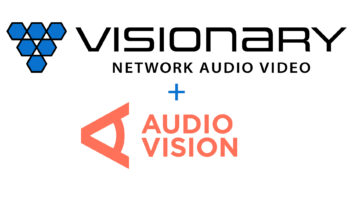 For decades, the broadcast industry relied on a standard and interoperable set of technologies for media creation and processing: SDI. People across production, post production, and transmission all used the same set of standards governing SDI, which delivered the high degree of interoperability and compliance necessary to ensure that two devices equipped with SDI interfaces would work together.
For decades, the broadcast industry relied on a standard and interoperable set of technologies for media creation and processing: SDI. People across production, post production, and transmission all used the same set of standards governing SDI, which delivered the high degree of interoperability and compliance necessary to ensure that two devices equipped with SDI interfaces would work together.
Throughout the industry’s migration from SDI to IP, AIMS has been working to foster adoption of a common set of standards that afford the video engineering community that same level of interoperability and confidence in using IP to build end-to-end systems. Without this committed focus, the move toward an IP future would have been a bumpy ride.
In the last year before we formed AIMS, back in 2015, there was a clear danger of fragmentation or splintering with respect to IP adoption because so many different groups and vendors were working on their own solutions. We were looking at four or five different proprietary implementations that were non-compatible, and that would have been a disastrous path. Although the industry’s move toward IP was inevitable, a fragmented approach to implementation would have slowed down the critical early progress being made at that point.
The only response that made sense was to come together and figure out a common roadmap, a common language, and a common message to drive adoption across the broader market. Committed to that mission as we launched AIMS, we focused on creating what we call the AIMS roadmap, which outlines a set of standards that enable interoperability across different systems and users. From the very beginning, AIMS collaborated with key technology and standards development groups to make sure that the roadmap we formally adopted was aligned with the direction those groups are going.
We partnered up with organisations including the Video Services Forum (VSF), which had already introduced a roadmap of sorts with its TR-03 and TR-04 technical recommendations. Through the work of SMPTE, those recommendations — along with standards from AES and NMOS specifications from AMWA — were incorporated into the SMPTE ST 2110 and SMPTE ST 2022 standards that today serve as the foundation for IP infrastructure for broadcast.
The same people driving standards development within VSF, SMPTE, AES, and AMWA are active participants within AIMS, and we recruited a core group of vendors and end users to join the alliance and bring momentum to adoption of standards-based IP.
That’s the role AIMS has played. Looking at the breadth of SMPTE ST 2110 adoption today, it seems we did the right thing. Because a significant segment of the industry agreed on that common roadmap early on, we’ve been able to move forward in realising the potential of IP. Over the past five years of work, we’ve been able to make five years of progress.
Over this time, SMPTE ST 2110 has become the de facto IP standard for every part of the broadcast industry, from servers, colour grading, and processing to contribution links. IP implementations are occurring all around the globe — and even in the cloud, with SMPTE ST 2110 running natively in a handful of cloud implementations.
Today, AIMS continues to execute on its original mission of promoting standards-based IP, and we continue to add new members. (We welcome both suppliers and end users to join as members!) End users are a valuable part of the AIMS community because they bring attention to new use cases and problems that need solving, and this is exactly how the new Internet Protocol Media Experience (IPMX) set of specifications and standards came about.
AIMS members dictate the direction the alliance will take in its work, and conversations among members clearly pointed to the Pro AV industry’s need for standards-based IP. Like the broadcast industry, the Pro AV market has been heavily reliant on SDI. As we looked into the requirements of Pro AV, we found the benefits of IP adoption to be even more compelling for that market than for broadcast.|
In short, a standards-based approach to IP for the Pro AV market would give countless organisations, from houses of worship to educational institutions and multinational companies, access to the many benefits of the increasingly mature global IP industry: lower-cost cabling, greater flexibility enabled by IP networking, rapidly dropping price points for IP infrastructure, and increasing density of switching and routing networks.
IPMX takes advantage of the R&D and investment in standards governing broadcast use cases and applies them to the requirements of Pro AV applications, which already leverage a great deal of broadcast technology. Given the success of SMPTE ST 2110 across the broadcast industry and the need for interoperable IP across the Pro AV industry, we feel confident that IPMX will facilitate immense and exciting change in a broad array of new implementations.
The industry has found that there is no production use case and no scale that standards-based IP can’t handle, and the economics of moving to SMPTE ST 2110 have likewise been proven out. Going forward, we can focus more on making IP systems easier to use, configure, and monitor, and that’s just what AMWA is doing with its expanding collection of NMOS specifications. With functionality such as auto discovery and the ability of devices to self-configure as they join the network, IP will soon offer many more operational benefits than SDI. The role of control systems will become richer. We’ll see advances in monitoring and automated exception handling.
An open standards-based platform invites in more software developers, as well as vendors building hardware and systems. New technologies and products will take advantage of increasingly robust IP standards and specifications, and all of these developments will combine to drive progress toward a better TCO.
The video industry has been fortunate in being able to ride the upward trajectory of the larger IP industry. But with all the advantages of IP come concerns common to IP networks. Thus, for AIMS, an ongoing focus will be educating the industry about best practices with respect to security. We continue to host webinars and industry events, such as the upcoming IP Oktoberfest, to continue supporting the migration to IP, and we’ll be demonstrating how to build an end-to-end implementation in IP that is truly resilient and has the proper security wrapped around it to ensure that neither the infrastructure nor operations can be compromised.
Fortunately, a growing generation of IP-aware engineers in broadcast has the knowledge necessary to build such implementations. What’s more, as they move out beyond major broadcast centres and production facilities, we’ll see even more creative and sophisticated use of IP in the field. Thanks largely to the industry’s commitment to standards-based IP, the future is bright, and we can expect broadening use of IP technologies across even more regions, organisations, and use cases.







